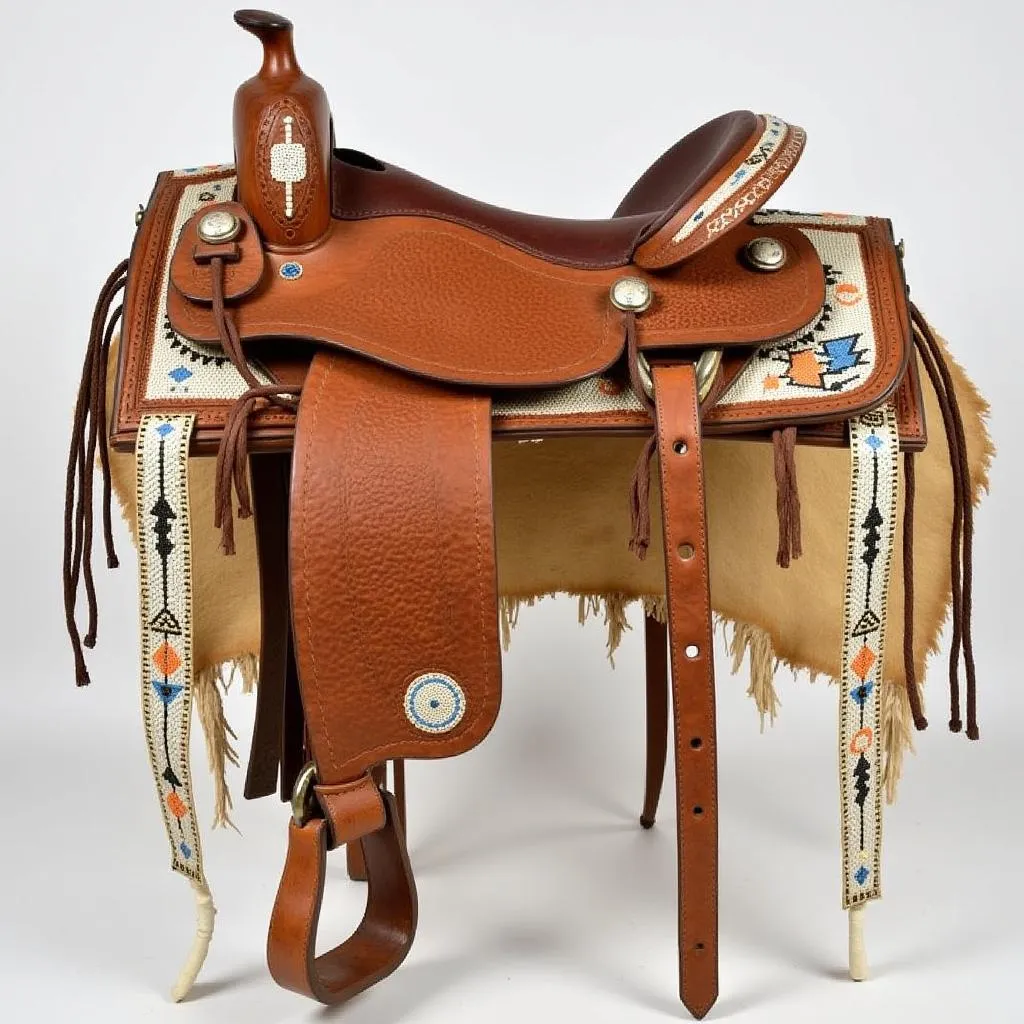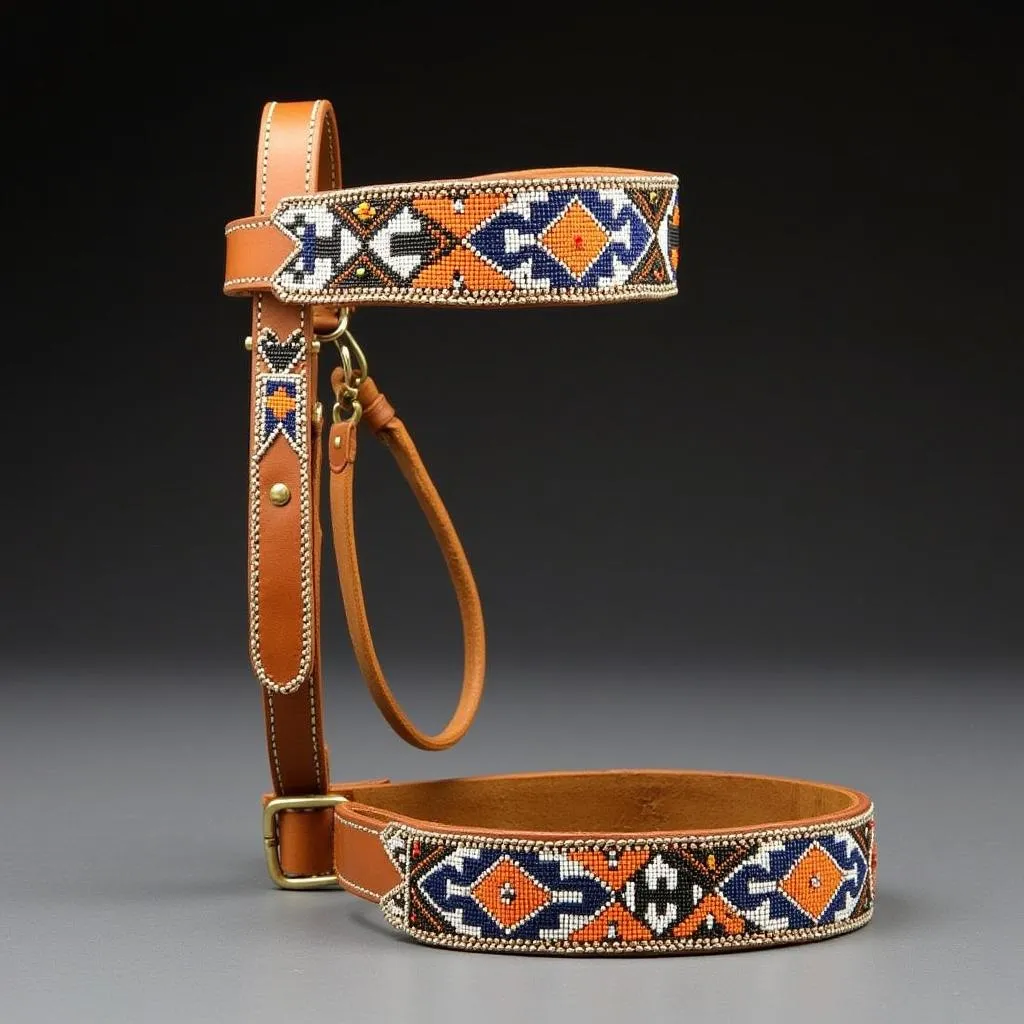Native American Horse Tack, an intricate tapestry of art, functionality, and cultural significance, embodies a rich heritage passed down through generations. From the plains of the Great West to the rugged landscapes of the Southwest, Native American tribes have long relied on horses for transportation, sustenance, and spiritual connection. Their unique approach to horse tack reflects their deep understanding of the horse’s anatomy and the demands of their diverse lifestyles.
Exploring the Foundations of Native American Horse Tack
The history of Native American horse tack is inextricably intertwined with the arrival of the horse in North America. While the exact timeline remains subject to debate, the most widely accepted theory suggests that horses arrived in North America with the Spanish conquistadors in the 16th century.
Initially, horses were not widely adopted by all Native American tribes. However, their utility for hunting, transportation, and warfare quickly became apparent. Over time, Native American tribes adapted their traditional hunting and warfare practices to incorporate horses, leading to a rapid transformation in their cultures and societies.
The Diverse Techniques and Materials of Native American Horse Tack
Native American horse tack showcases an impressive array of materials and techniques, reflecting the ingenuity and adaptability of the different tribes.
Common materials used include:
- Leather: From buffalo hide to elk and deer hide, Native American artisans carefully tanned and shaped leather to create saddles, bridles, reins, and other tack.
- Wood: Wood, often from cedar or juniper, was used for stirrups, saddle trees, and other structural components.
- Bone: Bone was utilized for decorative elements, such as conchos, as well as for practical components like needles and awls.
- Metal: Metals, such as copper, brass, and silver, were often incorporated for decorative purposes and to add durability.
- Beads: Beads, meticulously crafted from glass, bone, or shell, were used extensively for adornment, creating vibrant and intricate patterns on horse tack.
Traditional techniques:
- Tannin and Brain Tanning: Native Americans employed these methods to transform hides into supple and durable leather.
- Beadwork: Native American beadwork, often featuring intricate geometric patterns and symbolic motifs, played a significant role in decorating horse tack.
- Carving and Inlaying: The use of carving and inlay techniques, especially on wood and bone components, added decorative details and cultural symbolism.
The Symbolism and Cultural Significance of Native American Horse Tack
Native American horse tack is not merely functional; it also carries profound cultural and spiritual meaning. The intricate designs, patterns, and materials often convey specific narratives or symbolic representations.
Here are a few examples:
- Spirals: Spirals are a recurring motif in Native American art, symbolizing the cyclical nature of life and the interconnectedness of all beings.
- Geometric Patterns: Geometric patterns, such as diamonds and triangles, often represent constellations, celestial bodies, or tribal affiliations.
- Animal Representations: Images of animals, such as horses, birds, and buffalo, often depict the tribe’s relationship with the natural world and their reverence for the animal kingdom.
Beyond the visual aspects, Native American horse tack played a vital role in social interaction, ceremonial practices, and personal expression. The artistry and craftsmanship involved in creating this tack represented a form of storytelling and cultural preservation.
The Legacy of Native American Horse Tack
The legacy of Native American horse tack continues to inspire and influence artisans and horse enthusiasts today. It is a testament to the enduring spirit and craftsmanship of Native American cultures, showcasing their deep connection to the horse and their rich artistic traditions.
Today, many Native American artists and craftspeople continue to carry on this legacy, creating contemporary versions of traditional horse tack while incorporating modern techniques and materials. These pieces not only represent the past but also offer a glimpse into the future of this vibrant and enduring art form.
The Importance of Respect and Appreciation
As we admire and appreciate Native American horse tack, it’s crucial to recognize its cultural significance. Respecting the history and traditions associated with this artistry is essential.
Here are some tips for appreciating Native American horse tack:
- Learn about the different tribes and their specific styles of horse tack.
- Research the materials and techniques used in creating Native American horse tack.
- Explore the symbolism and meanings behind the designs and motifs.
- Support Native American artists and craftspeople who continue to preserve and revitalize these traditions.
By appreciating and honoring the legacy of Native American horse tack, we can foster a deeper understanding and appreciation for the rich cultural heritage that it represents.
Where to Find Native American Horse Tack
If you’re interested in exploring Native American horse tack, there are a number of resources available:
- Museums and Cultural Centers: Many museums and cultural centers across North America showcase collections of Native American horse tack.
- Native American Arts and Crafts Markets: These markets provide opportunities to purchase authentic pieces directly from Native American artists and craftspeople.
- Online Retailers: Several online retailers specialize in Native American art and crafts, including horse tack.
A Legacy that Endures
Native American horse tack is more than just functional equipment; it’s a testament to the ingenuity, artistry, and cultural resilience of Native American tribes. It reflects their deep understanding of the horse, their reverence for the natural world, and their enduring spirit.
As we explore and appreciate the artistry and cultural significance of Native American horse tack, we are reminded of the enduring legacy of these vibrant and resilient cultures.
FAQ
Q: What are some of the most common types of Native American horse tack?
A: Some common types of Native American horse tack include saddles, bridles, reins, stirrups, halters, and breast collars.
Q: What are some of the best places to learn more about Native American horse tack?
A: Museums, cultural centers, and online resources are excellent starting points for learning about Native American horse tack.
Q: What is the best way to appreciate and support Native American horse tack traditions?
A: By educating ourselves about the history and cultural significance of Native American horse tack, supporting Native American artists, and respecting the traditions associated with this art form, we can honor its legacy.
Q: Is it possible to find authentic Native American horse tack today?
A: Yes, many Native American artists and craftspeople continue to create authentic pieces of horse tack, incorporating traditional techniques and materials.
Q: What makes Native American horse tack unique?
A: Native American horse tack is unique due to its intricate designs, symbolic meanings, and the skillful craftsmanship involved in its creation. It reflects a deep understanding of the horse and a strong connection to the natural world.
Q: What is the best way to care for Native American horse tack?
A: To ensure the longevity of Native American horse tack, it’s important to use proper storage and cleaning methods. Consult with a reputable Native American art expert or craftsperson for specific care instructions.
 Native American Horse Tack Saddle
Native American Horse Tack Saddle
 Native American Horse Tack Bridle
Native American Horse Tack Bridle
If you’re interested in learning more about native American horse tack and have any further questions, feel free to contact us! We are happy to help!
We are available 24/7 at beaded horses, american indian horse tack, or call us at 0772127271. You can also reach us at [email protected] or visit our shop at QGM2+WX2, Vị Trung, Vị Thuỷ, Hậu Giang, Việt Nam.